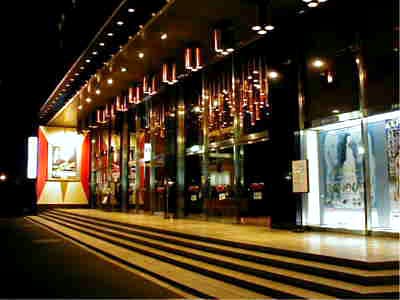| IMPERIAL THEATER |
| Names | Teikoku Gekij˘ Imperial Theater ThÚÔtre ImpÚrial |
||||||||||||||||||||||||||||||||||||||||||||
| City | T˘ky˘ | ||||||||||||||||||||||||||||||||||||||||||||
| History |
March 1911: opening of the Imperial Theater; the project is led by the businessman Shibusawa Eiichi and the three leading actors of the Kabuki troupe based in this theater are Onoe Baik˘ VI (onnagata), Ichikawa Komaz˘ VIII (tachiyaku) and Sawamura S˘jűr˘ VII (wagotoshi). November 1911: Ichikawa Komaz˘ VIII takes at the Imperial Theater the prestigious name of Matsumoto K˘shir˘ VII,
which has not been held since 11th lunar month of 1846. September 1914: premiere at the Imperial Theater of the dance "Onatsu Ky˘ran"; the roles of Onatsu and the pack-horse driver are played by Onoe Baik˘ VI and Matsumoto K˘shir˘ VII. 28 ~ 30 June 1915: first program of the Bungeiza at the Imperial Theater; the Bungeiza is a theater study group led by Morita Kan'ya XIII, which focuses on new productions (Shinkabuki, modern theater) and also the adaptations of Western plays, . March 1921: premiere at the Imperial Theater of the dance-drama "Chatsubo", which is adapted from ky˘gen to Kabuki by Okamura Shik˘ and stars Onoe Kikugor˘ VI and Band˘ Mitsugor˘ VII in the roles of the countryside servant Magoroku and the thief Kumataka Tar˘. February 1922: revival at the Imperial Theater of the Nagauta-based dance-drama "Tsuki no Kao Monaka no Natorigusa", which is entitled "Oniji Hy˘shimai" and staged for the first gala of the Hagoromokai from the 26th to the 28th of February 1922 with the following casting:
July 1922: premiere at the Imperial Theater of Tanizaki Jun'ichir˘'s drama "Okuni to Gohei", which is staged with the following casting:
September 1922: revival at the Imperial Theater of "Uir˘ Uri". It is entitled "Uir˘" and stars Ichikawa Sansh˘ V in the role of Soga Gor˘ Tokimune. The script has been written by Hirayama Shinkichi. March 1923: premiere at the Imperial Theater of Osanai Kaoru's drama "Musuko", which was staged with the following casting:
1 September 1923 (11:58 AM): T˘ky˘ is destroyed by a powerful earthquake called Kant˘ Daijishin, which kills more than 200,000 people; the Imperial Theater is destroyed. October 1924: the newly-rebuilt Imperial Theater reopens. June 1929: premiere at the Imperial Theater of Tsubouchi Sh˘y˘'s dance-drama "Ry˘kan to Komori", which was staged with the following casting:
December 1929: the management of the Imperial Theater is taken over by the Sh˘chiku Company. 1940: the management of the Imperial Theater is taken over by the T˘h˘. 10 March 1945 (00:08 AM): 344 US Army B29 bombers drops 2,000 tons of bombs on T˘ky˘, killing more than 120,000 people and destroying almost everything; the Imperial Theater is one of the few buildings, which were spared the destruction. October 1945: the Imperial Theater reopens; the troupe of Onoe Kikugor˘ VI appears on stage with a program which includes the dance "Kagami Jishi". September 1947: premiere at the Imperial Theater of Atsumi Seitar˘'s version of "Nans˘ Satomi Hakkenden", which is staged with the following casting:
|
||||||||||||||||||||||||||||||||||||||||||||
 |
|||||||||||||||||||||||||||||||||||||||||||||
| The fašade of The Imperial Theater | |||||||||||||||||||||||||||||||||||||||||||||
|
|
| Contact | Main | Top | Updates | Actors | Plays | Playwrights | Programs | Links | FAQ | Glossary | Chronology | Illustrations | Prints | Characters | Derivatives | Theaters | Coming soon | News |